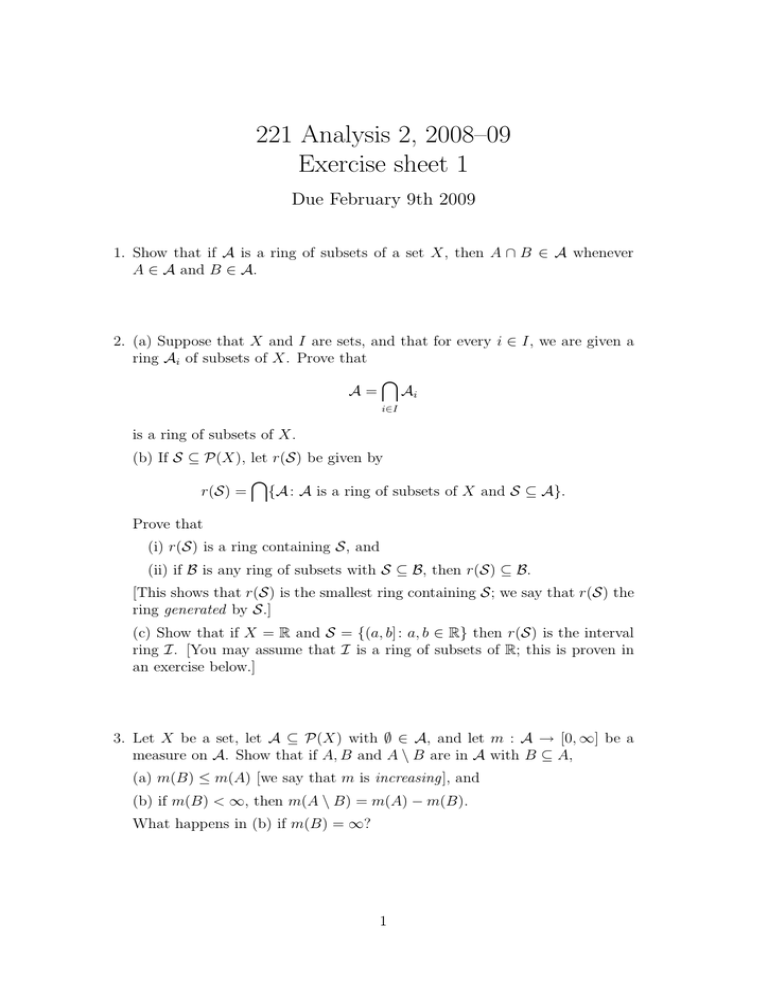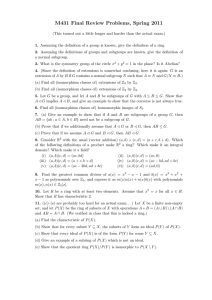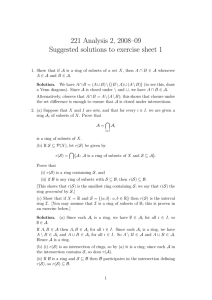221 Analysis 2, 2008–09 Exercise sheet 1 Due February 9th 2009
advertisement

221 Analysis 2, 2008–09
Exercise sheet 1
Due February 9th 2009
1. Show that if A is a ring of subsets of a set X, then A ∩ B ∈ A whenever
A ∈ A and B ∈ A.
2. (a) Suppose that X and I are sets, and that for every i ∈ I, we are given a
ring Ai of subsets of X. Prove that
\
A=
Ai
i∈I
is a ring of subsets of X.
(b) If S ⊆ P(X), let r(S) be given by
\
r(S) = {A : A is a ring of subsets of X and S ⊆ A}.
Prove that
(i) r(S) is a ring containing S, and
(ii) if B is any ring of subsets with S ⊆ B, then r(S) ⊆ B.
[This shows that r(S) is the smallest ring containing S; we say that r(S) the
ring generated by S.]
(c) Show that if X = R and S = {(a, b] : a, b ∈ R} then r(S) is the interval
ring I. [You may assume that I is a ring of subsets of R; this is proven in
an exercise below.]
3. Let X be a set, let A ⊆ P(X) with ∅ ∈ A, and let m : A → [0, ∞] be a
measure on A. Show that if A, B and A \ B are in A with B ⊆ A,
(a) m(B) ≤ m(A) [we say that m is increasing], and
(b) if m(B) < ∞, then m(A \ B) = m(A) − m(B).
What happens in (b) if m(B) = ∞?
1
4. (a) Show that for any a, b, c, d ∈ R,
(a, b] ∩ (c, d] = (max(a, c), min(b, d)],
(a, b] ∩ (−∞, d] = (a, min(b, d)] and
(a, b] ∩ (c, ∞) = (max(a, c), b].
[If b ≤ a then (a, b] is the empty set.]
(b) Suppose that B = (a1 , b1 ] ∪ · · · ∪ (an , bn ] where a1 < b1 < a2 < b2 < · · · <
bn−1 < an < bn . Write B ∁, the complement of B in R, as a union of n + 1
intervals.
(c) Show that the interval ring
I = {(a1 , b1 ] ∪ · · · ∪ (an , bn ] : n ≥ 1, ai , bi ∈ R, 1 ≤ i ≤ n}
is a ring of subsets of R. [Hint: A \ B = A ∩ B ∁.]
5. Let A = A1 ∪ · · · ∪ An where Ai = (ai , bi ] and a1 < b1 < a2 < · · · < bn−1 <
an < bn , and suppose there are real numbers bj , cj such that A can also be
written as
∞
[
A=
Bj where Bj = (cj , dj ].
j=1
Prove that there is a partition N = S1 ∪S2 ∪· · ·∪Sn such that for i = 1, 2, . . . , n
we have
[
Ai =
Bj .
j∈Si
[We write N = {1, 2, 3, . . . }; a partition is simply a disjoint union.]
2








